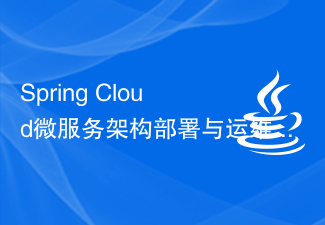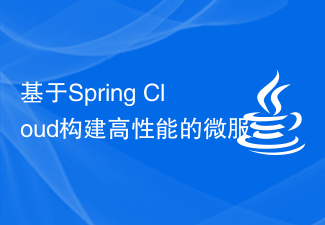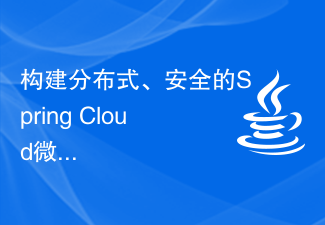 Java
Java javaTutorial
javaTutorial Implementation of using Spring Cloud Netflix Zuul proxy gateway to access backend REST services (code)
Implementation of using Spring Cloud Netflix Zuul proxy gateway to access backend REST services (code)The content this article brings to you is about the implementation (code) of using Spring Cloud Netflix Zuul proxy gateway to access the backend REST service. It has certain reference value. Friends in need can refer to it. I hope it will be helpful to you. help.
1. Overview
In this article, we will explore how to communicate between a front-end application and a back-end REST API service that are deployed separately from each other. The purpose is to solve the browser's cross-domain resource access and same-origin policy restrictions, allowing the page UI to call the background API even if they are not in the same server.
We have created two separate applications here - a UI application and a simple REST API, and we will use Zuul proxy in the UI application to proxy calls to the REST API. Zuul is Netflix's JVM-based router and server-side load balancer. Spring Cloud has great integration with embedded Zuul proxy.
2.REST application
Our REST API application is a simple Spring Boot application. In this article, the API deployed in the server will be run on port 8081.
Configuration File
server.contextPath=/spring-zuul-foos-resourceserver.port=80 81
Let’s first define a basic DTO for the resource we will use:
public class Foo {
private long id;
private String name;
// standard getters and setters
}Define a simple controller:
@Controllerpublic class FooController {
@RequestMapping(method = RequestMethod.GET, value = "/foos/{id}")
@ResponseBody
public Foo findById(
@PathVariable long id, HttpServletRequest req, HttpServletResponse res) {
return new Foo(Long.parseLong(randomNumeric(2)), randomAlphabetic(4));
}
}3 . Front-End Application
Our UI application is also a simple Spring Boot application. In this article the application is running on port 8080.
First we need to add dependency for zuul support via Spring Cloud to our UI application's pom.xml:
<dependency>
<groupId>org.springframework.cloud</groupId>
<artifactId>spring-cloud-starter-netflix-zuul</artifactId></dependency>Next - We need to configure Zuul since we are using Spring Boot, so we will do this in application.yml:
zuul:
routes:
foos:
path: /foos/**
url: http://localhost:8081/spring-zuul-foos-resource/foosNOTE:
We proxy our resource server Foos.
All requests starting with "/foos/" from the UI will be routed to our Foos resource server at: http://loclahost:8081/spring-zuul- foos-resource/foos/
Then write our main page index.html — using some AngularJS here:
<html>
<body ng-app="myApp" ng-controller="mainCtrl">
<script src="angular.min.js"></script>
<script src="angular-resource.min.js"></script>
<script>
var app = angular.module('myApp', ["ngResource"]);
app.controller('mainCtrl', function($scope,$resource,$http) {
$scope.foo = {id:0 , name:"sample foo"};
$scope.foos = $resource("/foos/:fooId",{fooId:'@id'});
$scope.getFoo = function(){
$scope.foo = $scope.foos.get({fooId:$scope.foo.id});
}
});</script><p>
<h1 id="Foo-nbsp-Details">Foo Details</h1>
<span>{{foo.id}}</span>
<span>{{foo.name}}</span>
<a href="#" ng-click="getFoo()">New Foo</a>
</p>
</body>
</html>The most important aspect here is how we use relative URL access API!
Keep in mind that the API application is not deployed on the same server as the UI application, so relative URLs will not work and will not work without a proxy.
However, through the proxy, we access the Foo resources through the Zuul proxy, which is configured to route these requests to where the API is actually deployed.
Finally, the Boot-enabled application:
@EnableZuulProxy@SpringBootApplicationpublic class UiApplication extends SpringBootServletInitializer {
public static void main(String[] args) {
SpringApplication.run(UiApplication.class, args);
}
}The @EnableZuulProxy annotation is used here to start the Zuul proxy, which is very clean and concise.
4. Run the test
Start 2 application systems respectively, enter http://localhost:8080/index in the browser
Visit each time you click the "New Foo" button Backend REST API once. 
5. Customized Zuul filter
There are multiple Zuul filters available, we can also create our own custom filter:
@Componentpublic class CustomZuulFilter extends ZuulFilter {
@Override
public Object run() {
RequestContext ctx = RequestContext.getCurrentContext();
ctx.addZuulRequestHeader("Test", "TestSample");
return null;
} @Override
public boolean shouldFilter() {
return true;
} // ...}This A simple filter just adds an attribute called "Test" to the request header - of course, we can add more to our request as needed.
6. Testing Custom Zuul Filters
Finally, let’s test to make sure our custom filter is working - first we’ll modify our FooController on the Foos resource server:
@Controllerpublic class FooController {
@GetMapping("/foos/{id}") @ResponseBody
public Foo findById(
@PathVariable long id, HttpServletRequest req, HttpServletResponse res) {
if (req.getHeader("Test") != null) {
res.addHeader("Test", req.getHeader("Test"));
} return new Foo(Long.parseLong(randomNumeric(2)), randomAlphabetic(4));
}
}Now - Let’s test it out:
@Testpublic void whenSendRequest_thenHeaderAdded() {
Response response = RestAssured.get("http://localhost:8080/foos/1");
assertEquals(200, response.getStatusCode());
assertEquals("TestSample", response.getHeader("Test"));
}7. Conclusion
In this post, we focused on routing requests from UI application to REST using Zuul API. We successfully solved the CORS and Same Origin Policy, and we also managed to customize and augment the HTTP requests in transit.
Related recommendations:
spring cloud's Feign uses HTTP to request remote services
##spring-cloud-sleuth zipkin tracking service Implementation (2)
The above is the detailed content of Implementation of using Spring Cloud Netflix Zuul proxy gateway to access backend REST services (code). For more information, please follow other related articles on the PHP Chinese website!
 Spring Cloud微服务架构部署与运维Jun 23, 2023 am 08:19 AM
Spring Cloud微服务架构部署与运维Jun 23, 2023 am 08:19 AM随着互联网的快速发展,企业级应用的复杂度日益增加。针对这种情况,微服务架构应运而生。它以模块化、独立部署、可扩展性高等特点,成为当今企业级应用开发的首选。作为一种优秀的微服务架构,SpringCloud在实际应用中展现出了极大的优势。本文将介绍SpringCloud微服务架构的部署与运维。一、部署SpringCloud微服务架构SpringCloud
 Java语言中的Spring Cloud框架介绍Jun 09, 2023 pm 10:54 PM
Java语言中的Spring Cloud框架介绍Jun 09, 2023 pm 10:54 PMJava语言中的SpringCloud框架介绍随着云计算和微服务的流行,SpringCloud框架成为了Java语言中构建云原生应用的首选框架之一。本文将介绍SpringCloud框架的概念和特点,以及如何使用SpringCloud构建微服务架构。SpringCloud简介SpringCloud框架是基于SpringBoot的微服务框架。它为
 实现分布式锁的Spring Cloud微服务实践Jun 22, 2023 pm 11:28 PM
实现分布式锁的Spring Cloud微服务实践Jun 22, 2023 pm 11:28 PM随着微服务架构的流行,越来越多的企业开发团队开始使用SpringCloud构建自己的微服务系统。在分布式环境下,实现分布式锁是一项重要的技术挑战。本文将介绍在SpringCloud框架下,如何实现分布式锁的微服务实践。首先,我们需要了解什么是分布式锁。分布式锁是一种用于保护共享资源的访问的技术,它可以保证在分布式环境下多个节点不会同时对同一资源进行修改或
 基于Spring Cloud构建高性能的微服务架构Jun 22, 2023 pm 11:15 PM
基于Spring Cloud构建高性能的微服务架构Jun 22, 2023 pm 11:15 PM随着互联网应用的不断发展,越来越多的企业和组织开始采用微服务架构来构建应用系统。相比于传统的单体应用架构,微服务架构可以提供更高的可扩展性、灵活性和稳定性,同时也可以更好地满足业务需求。基于SpringCloud框架,我们可以很方便地构建高性能的微服务架构。SpringCloud由Spring团队打造,是一个完整的微服务框架,提供了各种工具和组件,能够支
 Spring Cloud微服务架构与运维Jun 22, 2023 am 10:36 AM
Spring Cloud微服务架构与运维Jun 22, 2023 am 10:36 AM随着互联网技术的发展,微服务架构已经逐渐成为了互联网企业的主流技术选型。而SpringCloud作为一个开源的微服务架构解决方案,受到了越来越多企业的关注和采用。本文将围绕SpringCloud微服务架构与运维展开阐述,主要分为以下几个方面:SpringCloud微服务架构概述SpringCloud是一个开源的、轻量级的微服务框架,它提供了一系列的分
 Spring Cloud微服务架构下的负载均衡算法优化Jun 22, 2023 am 10:33 AM
Spring Cloud微服务架构下的负载均衡算法优化Jun 22, 2023 am 10:33 AM随着微服务架构的流行,负载均衡算法的优化越来越受到关注。SpringCloud作为一个流行的微服务框架,在负载均衡方面也提供了多种算法。本文将介绍SpringCloud微服务架构下的负载均衡算法优化,探讨如何选择适合自己的负载均衡算法。一、什么是负载均衡在讨论负载均衡算法之前,先了解一下负载均衡的概念。负载均衡(LoadBalancing)是一种分摊网
 Spring Cloud微服务架构下的监控与告警实践Jun 22, 2023 pm 03:04 PM
Spring Cloud微服务架构下的监控与告警实践Jun 22, 2023 pm 03:04 PM随着微服务架构的广泛应用,如何有效地监控和告警成为了开发人员和运维人员面临的问题之一。本文将重点介绍在SpringCloud微服务架构下实践监控和告警的具体方法。一、监控指标的选择在进行监控之前,首先需要确定需要监控的指标。常见的指标包括:CPU利用率、内存使用率、网络带宽、磁盘空间、HTTP请求的响应时间、服务调用的次数和延迟等。这些指标可通过各种监控工
 构建分布式、安全的Spring Cloud微服务飞行系统Jun 22, 2023 am 08:06 AM
构建分布式、安全的Spring Cloud微服务飞行系统Jun 22, 2023 am 08:06 AM随着云计算的发展和企业业务的不断扩张,微服务架构已经成为了一个非常流行的系统架构。其中,SpringBoot和SpringCloud是目前最为常用的微服务框架。SpringCloud提供了丰富的组件来支持微服务的开发和管理,包括服务注册与发现、路由、负载均衡、配置管理、断路器等。在本篇文章中,我们将构建一个分布式、安全的SpringCloud微服务飞


Hot AI Tools

Undresser.AI Undress
AI-powered app for creating realistic nude photos

AI Clothes Remover
Online AI tool for removing clothes from photos.

Undress AI Tool
Undress images for free

Clothoff.io
AI clothes remover

AI Hentai Generator
Generate AI Hentai for free.

Hot Article

Hot Tools

Dreamweaver Mac version
Visual web development tools

MinGW - Minimalist GNU for Windows
This project is in the process of being migrated to osdn.net/projects/mingw, you can continue to follow us there. MinGW: A native Windows port of the GNU Compiler Collection (GCC), freely distributable import libraries and header files for building native Windows applications; includes extensions to the MSVC runtime to support C99 functionality. All MinGW software can run on 64-bit Windows platforms.

MantisBT
Mantis is an easy-to-deploy web-based defect tracking tool designed to aid in product defect tracking. It requires PHP, MySQL and a web server. Check out our demo and hosting services.

Atom editor mac version download
The most popular open source editor

Notepad++7.3.1
Easy-to-use and free code editor






